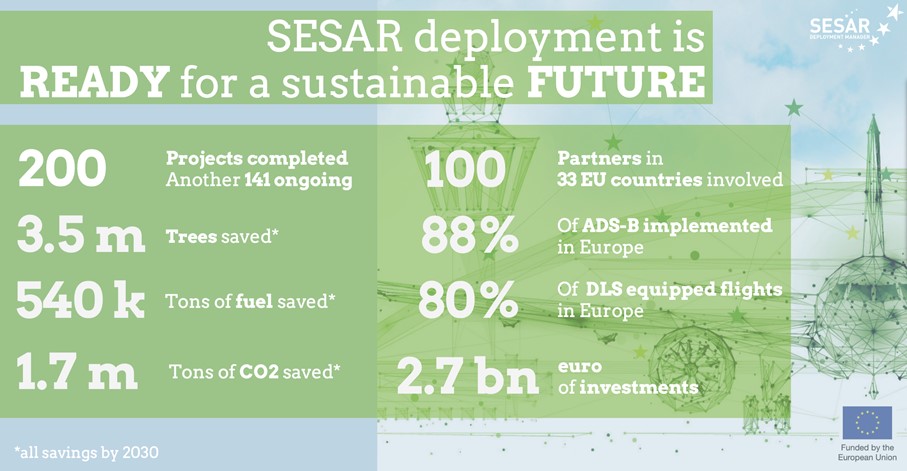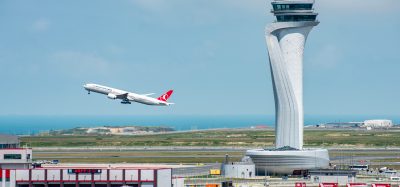SESAR deployment drives efficient, modern ATM
- Like
- Digg
- Del
- Tumblr
- VKontakte
- Buffer
- Love This
- Odnoklassniki
- Meneame
- Blogger
- Amazon
- Yahoo Mail
- Gmail
- AOL
- Newsvine
- HackerNews
- Evernote
- MySpace
- Mail.ru
- Viadeo
- Line
- Comments
- Yummly
- SMS
- Viber
- Telegram
- Subscribe
- Skype
- Facebook Messenger
- Kakao
- LiveJournal
- Yammer
- Edgar
- Fintel
- Mix
- Instapaper
- Copy Link
Posted: 24 November 2021 | Mariagrazia La Piscopia | No comments yet
For International Airport Review, Mariagrazia La Piscopia, Chief Strategy and Programme Management SESAR Deployment Manager, details the progress of SESAR Deployment and the benefits it is already bringing to the ATM sector, made more prevalent as the industry emerges from the pandemic.


Can you give us an update on the status of the SESAR Deployment?
Through the SESAR Deployment Alliance (SDA), mandated by the European Commission as the SESAR Deployment Manager (SDM) for the past seven years, industry is in the driving seat of Europe’s ATM modernisation. This has a clear added value: the aviation industry knows the business, has high interests into a more performing aviation, acknowledges the need for implementing innovative technologies, and knows how to work together to achieve results.
That is why, in the past seven years, a lot has been achieved by the SESAR Deployment Manager, together with its stakeholders, in terms of modernising ATM. Today, we are close to 200 completed projects and 141 are ongoing. We are talking about nearly €3 billion of investments in the 2015 to 2024 timeframe.
It is remarkable that despite the COVID-19 crisis and the strong reduction of traffic, our closed projects have already enabled €1 billion of savings for the ATM community. In the coming years, when more and more projects will close, another €15 billion will follow, thus demonstrating the strong will of the industry to continue ATM modernisation.”
These projects are not just ticking a checklist. The completed ones are already delivering robust operational and performance benefits to the community: from shorter and more efficient flight routes, more efficient operations for arrivals over departure, and reduced taxi times at the airport to setting up new digital information management. All in all, this means less emissions and less fuel consumption – a step forward in the fight against climate change.
We need to further digitalise and optimise infrastructure, especially on CNS, make ATM systems more scalable and resilient and, of course, contribute to the reduction of CO2 emissions to fight climate change.

Why does the European airspace need to undergo this modernisation?
The journey towards a more sustainable Single Digital European Sky and a more environmentally friendly air traffic management shall continue, but it is still far from being completed. What started with SESAR has brought great results and is continuing to deliver, but there are new challenges to be addressed.
We need to join forces especially now, after the hit of the pandemic which had an impact that nobody could have ever anticipated. Air traffic is starting to come back, and we need to have an efficient infrastructure in place to handle it, avoiding unnecessary delays and reducing carbon emissions to the minimum. This means more efficient and shorter flight paths, preventing congestion at airport level and always maintaining the highest safety standards.
All of this can only be done if stakeholders and European institutions join forces, this is where the added value of the SESAR Deployment Manager lies. Unsynchronised deployment is always slower and does not guarantee performance benefits. If deployment is co-ordinated, instead, benefits for aviation, and in turn for passengers and economy, are maximised. The SESAR Deployment Manager acts as a catalyst towards this goal. Implementation would have been way slower without our support.
What will be the benefits to the passenger? What will be the benefits to the environment?
New ATM technologies and procedures can improve the efficiency of airspace and operations but will also allow a better and more flexible use of resources. Improved operations always have a positive impact on passengers’ travel experience.
Furthermore, digitalisation and automation are key to enhancing capacity (both airspace and airport capacity), again reducing costs, delays and ensuring scalability to grant resilience to the entire system.
With regards to the reduction of aviation’s impact on the environment, from our estimation, Common Project 11addresses inefficiencies in several phases of flight and reduces the entire excess CO2 emissions by 11 per cent (reduction of 111kg CO2 per flight). These are tangible results. The total savings in 2030 will reach 1.7 million tonnes of CO2 in Europe. The cumulated savings up to 2030 will be over 10.4 million tonnes of CO2.
Indeed, this approach and results are a first important step in getting prepared for the new propulsion systems such as batteries and hydrogen, and the use of sustainable aviation fuels.
How will it make European aviation more competitive with other global aviation markets?
The focus of our activities is to transform the European ATM systems and infrastructure and make it fit for the great challenges of the future. The better, safer, and more efficient ATM operations will be in the European skies, the easier it will be for Europe to reinforce its global role as connectivity hub. A greener and defragmented airspace, with no bottlenecks and a minimum number of delays, is an asset for the European aviation industry.
As proof of this, it is worth mentioning our co-operation with the Federal Aviation Administration under the framework of the EU – US Memorandum of Understanding: the target is to ensure harmonisation between the EU and the U.S. in the ATM modernisation field.
Operational stakeholders seem to have a key role in SESAR deployment?
There are two ways in which operational stakeholders play a key role in SESAR deployment:
- The first one is the most obvious: it’s the ATM industry which is investing to modernise the systems and infrastructure, building the ATM of the future. There is EU public funding in support, but most of the investment is still the responsibility of the ANSPs, airports and airlines, MET providers, etc.
- The second is perhaps less evident, but equally if not more important: we decided to work together and step up our role in coordinating, steering, and fostering deployment. The SESAR deployment itself is a proof of industry taking a role and that supporting the EU institutions with its competences and expertise is now a success story.
Engaging stakeholders in the two ways mentioned above is making the difference: airspace users, air navigation service providers, airports, meteo service providers, and many other partners (the entire framework partnership is bringing together almost 100 implementing partners) are working together towards the same goal: modernising and digitalising European aviation to deliver concrete benefits to the environment, European passengers, citizens, and economy.
What will be the key drivers for a smooth continuation of ATM modernisation through SESAR?
- Stakeholder direct participation in the definition of deployment strategies, their buy-in and involvement: without the aviation operational partners implementing the SESAR solutions in real life and daily operations, there is no modernisation nor digitalisation, nor a greener ATM. As SDM, we worked to develop a trust framework that led to full buy-in, also thanks to our unique consultation process – and we should regard it as an asset.
- Continuation of SESAR deployment manager function: the SDM function should continue and should keep valorising the unprecedented pioneer experience of the Alliance established in 2014 to cover this role. To face the upcoming challenges, we should make it even stronger, with tighter links with the ATM operational environment and taking into full consideration the EU network perspective. This is also why there is now a strong cooperation with EUROCONTROL and with the Network Manager.
- European financial support will remain crucial for every stakeholder, especially the smaller ones or the ones with negative business cases to be able to modernise and digitalise at the required speed. We are facing big challenges, and we need big investment to meet them, therefore financial support incentivisation will play an important role for the future ATM modernisation.
What are the future challenges?
The key is to work together creating the right synergies. For the future, co-operation in the field of innovation through SESAR will need to become even stronger than what it already is today. ATM in Europe is more and more interconnected, from the geographical and technological standpoint. No country, no stakeholder category, association but also institution in the aviation ecosystem, from R&I to deployment, can move on its own. The target will be to create at the end one single ATM value chain from R&D, over standardisation, industrialisation, deployment and finally to operations.
At the same time, I believe that one of the most urgent challenges the entire aviation is facing now, is overcoming the impact of the COVID-19 crisis. Today, we are still at –25 per cent traffic compared to equivalent days in 2019, according to the latest data provided by EUROCONTROL. Traffic has started to come back, but we could expect at least another 24 months before we are back to pre-COVID-19 pandemic levels.
How does the future of ATM look to you?
We need to be prepared for when traffic returns to pre-pandemic volumes:
- We must avoid the congestion problems we faced before the crisis, with too many delays for airlines and passengers. Traffic will return, and the capacity crunch will follow if we don’t act accordingly. Systems must continue to be upgraded to cope with this and with the forthcoming entrance of new vehicles and drones into the picture: in particular, the system and infrastructure shall be more scalable in managing the traffic growth
- We must ensure aviation plays its part in fighting climate change, continuing to reduce carbon emissions. Most of it will come from new sustainable fuels, and in the longer run by new and innovative aircraft, but there is something we can do today to further optimising ATM infrastructure and operations
- We need to keep an inclusive co-operation and co-ordination with all stakeholders, joining the forces of the ATM community towards common goals.
References
1) Regulation (EU) n. 2021/116
Biography


Mariagrazia is responsible for the development of the SESAR Deployment Programme – its monitoring and execution.
The Deployment Programme is a key tool for European ATM modernisation, guiding the necessary innovation investments and deployment strategies for airlines, airport and Air Navigation Service Providers. It is also the single specification to support funding opportunities for stakeholders through the Connecting Europe Facility (CEF).
Before joining SDM, Mariagrazia was Head of International Co-ordination and ATM Planning in the International Strategies directorate of one of the major European Air Navigation Service Providers (ENAV S.p.A.), contributing to the enhancement of the company role and the improvement of its positioning, both at European and global level. She has been involved in, and committed to, the development of some of the major European Aviation initiatives over the past decades, including the Single European Sky and SESAR Programme.
Related topics
Air traffic control/management (ATC/ATM), Airside operations, COVID-19, Digital transformation, Emissions, In-flight activity, New technologies, Passenger experience and seamless travel, Safety, Sustainability, Sustainable Aviation Fuel (SAF), Sustainable development
Related organisations
EUROCONTROL, SESAR, SESAR Deployment Alliance, SESAR Deployment Manager


















